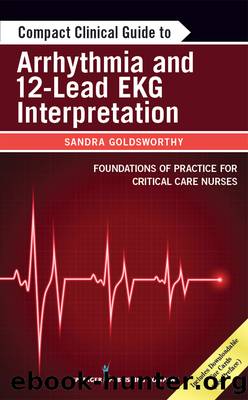Compact Clinical Guide to Arrhythmia and 12-Lead EKG Interpretation by Goldsworthy Sandra RN MSc PhD(c) CNCC(C) CMSN(C); Graham Leslie RN MN CNCC(C) CHSE;

Author:Goldsworthy, Sandra, RN, MSc, PhD(c), CNCC(C), CMSN(C); Graham, Leslie, RN, MN, CNCC(C), CHSE;
Language: eng
Format: epub
Publisher: Springer Publishing Company
Published: 2016-06-03T09:30:00+00:00
First-Degree AV Block
Figure 4.1 Two examples of first-degree heart block.
Unique Characteristics
Rhythm
Regular
Rate
60â100 beats/minute
P waves
Upright, symmetrical, one for every QRS
PRi
Prolonged > 0.20 seconds
QRS
0.06â0.10 seconds
Causes
First-degree heart block can be a normal finding in some people but other causes include ischemia to the AV node area, rheumatic heart disease, myocardial infarction (MI), increased vagal tone, or increased potassium.
Treatment
Treatment is not required for first-degree heart block as it is typically asymptomatic. It is important, however, to continue to monitor for an increasing block, which can occur with prolonged ischemia at the AV node/junctional tissue area.
Tips for Interpretation
First-degree heart block looks identical to normal sinus rhythm with one key difference; the PRi is prolonged (> 0.20 seconds) and constant.
Download
This site does not store any files on its server. We only index and link to content provided by other sites. Please contact the content providers to delete copyright contents if any and email us, we'll remove relevant links or contents immediately.
When Breath Becomes Air by Paul Kalanithi(7253)
Why We Sleep: Unlocking the Power of Sleep and Dreams by Matthew Walker(5636)
Paper Towns by Green John(4163)
The Immortal Life of Henrietta Lacks by Rebecca Skloot(3820)
The Sports Rules Book by Human Kinetics(3581)
Dynamic Alignment Through Imagery by Eric Franklin(3481)
ACSM's Complete Guide to Fitness & Health by ACSM(3459)
Kaplan MCAT Organic Chemistry Review: Created for MCAT 2015 (Kaplan Test Prep) by Kaplan(3418)
Introduction to Kinesiology by Shirl J. Hoffman(3297)
Livewired by David Eagleman(3113)
The River of Consciousness by Oliver Sacks(2988)
Alchemy and Alchemists by C. J. S. Thompson(2908)
The Death of the Heart by Elizabeth Bowen(2895)
Descartes' Error by Antonio Damasio(2728)
Bad Pharma by Ben Goldacre(2722)
The Gene: An Intimate History by Siddhartha Mukherjee(2487)
Kaplan MCAT Behavioral Sciences Review: Created for MCAT 2015 (Kaplan Test Prep) by Kaplan(2483)
The Fate of Rome: Climate, Disease, and the End of an Empire (The Princeton History of the Ancient World) by Kyle Harper(2429)
The Emperor of All Maladies: A Biography of Cancer by Siddhartha Mukherjee(2427)
